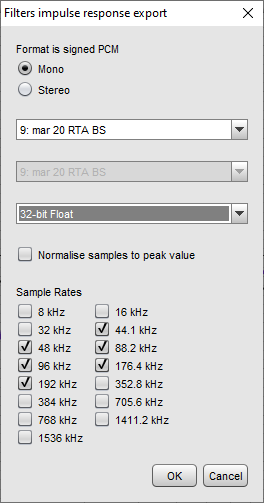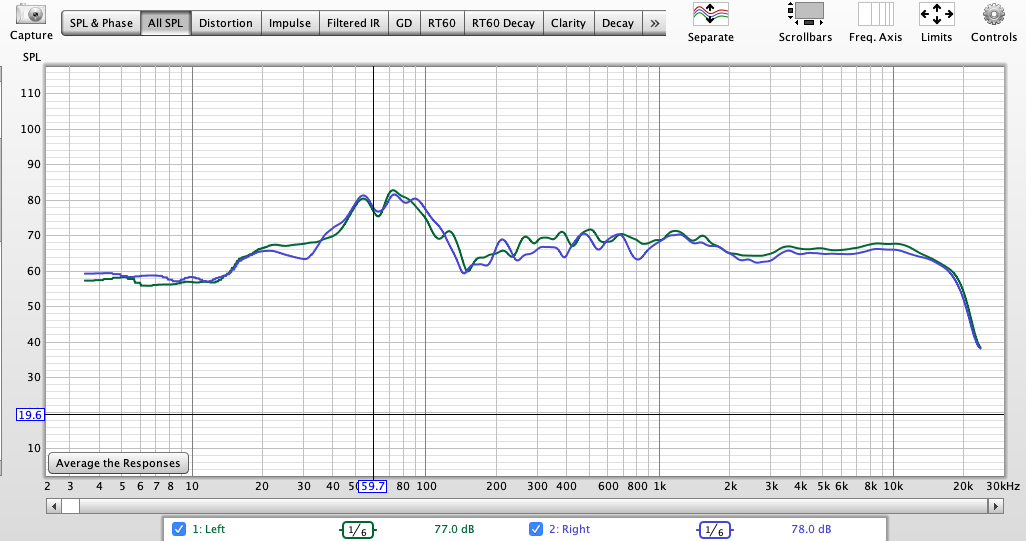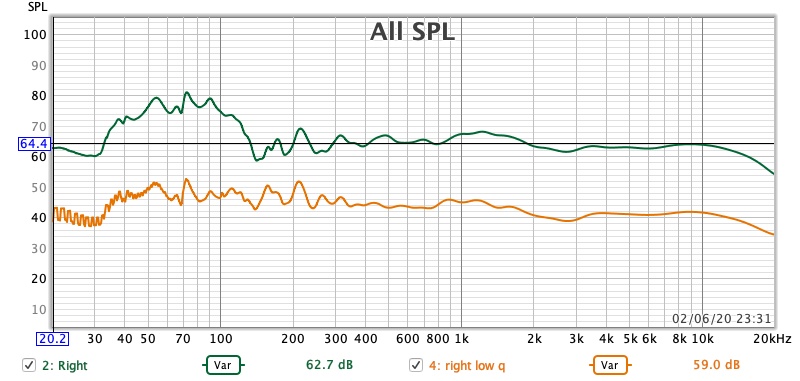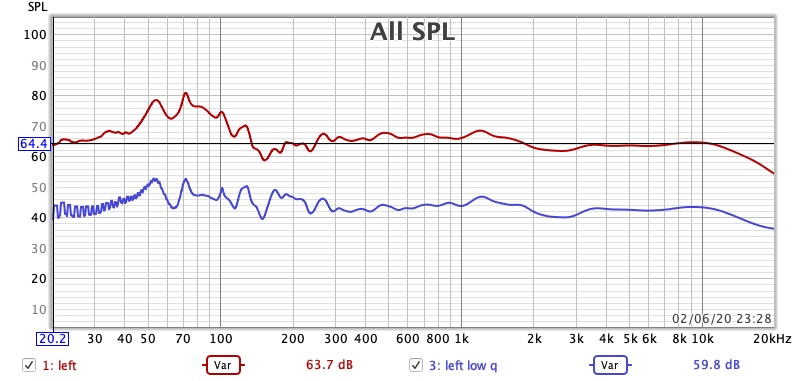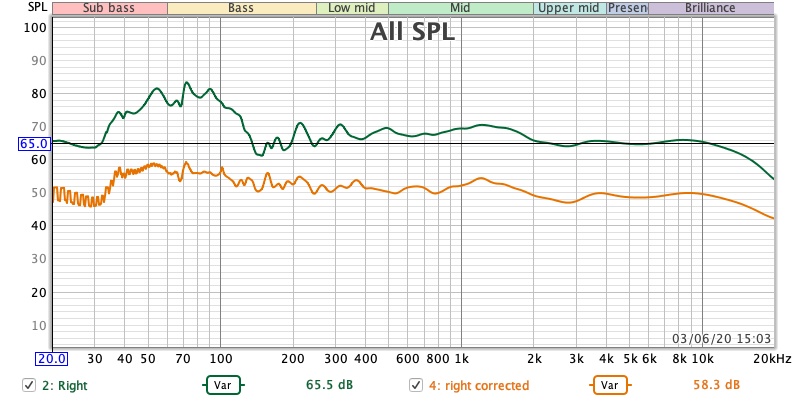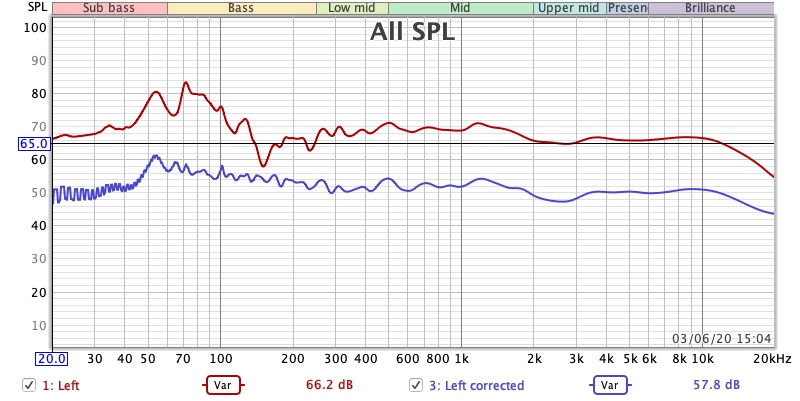As the graph title says “predicted”, this is likely no real measurement.
In real life, the system goes as deep as 30 Hz, without a problem. You can hear 25 Hz (testtones) but without much impact. 30 Hz goes as loud as for example a 70 Hz tone. Also, keep in mind, there are two 8" subwoofers.
I have standmounts with 6.5 inch midrange/bass drivers that play full volume at 35Hz and -5dB at 30hz, so even relatively small drivers can play bass good if the cabinet and quality is high enough (but you need a little help from the room). Btw, my user icon is picture of the driver 
What do you mean by moving the microphone in a spiral? Do you move it around freely with your hands without making a noise?
Yes, the idea is to get a good averaging outside each ear. I use spiral moves but other ways also works as long as you get a decent coverage and do the same outside both ears.
Thanks Magnus
It says in the Roon knowledge base
Blockquote
Filter resampling
If no filter is available that exactly matches the playback sample rate, Roon will resample the provided impulse response file to match.
You can avoid filter resampling by providing a separate filter for each sample rate. This can improve performance–both CPU performance and sonic performance–so you should try to provide a filter for each rate when possible.
You can also avoid filter resampling by configuring Roon to resample all content to the rate that matches your filter using Sample Rate Conversion.
Blockquote
What sample rates do you output to a wav file? And then afterwards do you zip them?
You can generate one convolution file for every possible input rate, and Roon will select the matching one automatically (put them all in a .zip and select that file). Typically you you want at least up to 96khz to cover first unfold of MQA in Roon, but if you have higher rates locally or use Qobuz you want to have up to 192 (i.e. 44, 48, 88, 96, 176, 192).
In recent versions of REW this is easy to do (these are the settings I use)
Here is my frequency response for both left and right speakers using the RTA method. They are similar with a large hump at the beginning. Is it better to EQ both pairs together i.e. remeasure using RTA with both speakers working together? Should I limit the EQ to 300hz?
That looks perfect for digital correction. My suggestion is to try one correction for stereo and one for mono, both to 500Hz, and use the one that sounds best. Target should be at the level you correct to, in this case 500Hz which looks to be 69dB.
Thank you Magnus
This is my corrected left and right speaker calibration removing the hump with a low number of EQ filters and a Q value of 5 or less. The top line is the original measurement the bottom is the corrected measurement. I also added a house curve.
Looks good, maybe a little conservative (I think you can fill those small dips you have). If you do an auto-correct in REW, 20Hz - 500Hz target 69dB, how will that look? In your case you don’t need to be to concerned about Q since you have no steep dips.
You can set flatness to 2 or 3dB to get REW to use less filters, or disable filters in the EQ filters window, you should get good result with maybe 5 filters.
Yes that looks very good, and should sound good as well although you will preobably miss the extra bass you removed. But use it for a few days and then disable it and you will notice how much better it sounds.
Not many filters used from the look of it, probably no high Q used either.
I was playing around with this before I buy a proper USB mic and was trying to play the Pink tone, but getting it anywhere near 75db is insanely loud. Am I doing something wrong?
Use a high volume and do measurements. If 75dB is to high then try 70 or 65 instead. The important thing is that you want it much higher than any background noise to get a good measurement (preferable 20dB higher or more).
I did the same as you. After reading Magnus’s tutorial I was anxious to get started. I also found the noise level high at 75dB just using my computer mic and the REW meter. Once I got my mic I found 75dB much more comfortable. I think it may have something to do with the mic calibration on your computer.
I also want to take this time to thank @Magnus for this great tutorial. I’ve had a great time tuning up my KEF LS50 wireless and the results are outstanding in a desktop setup.
Agreed thanks @Magnus for the hard work and continuing to reply.
I have a further question, apologies if this is silly or has been asked before. I currently do not have a recommended measurement mic, however I do have a Blue Yeti USB mic. I’m aware this doesn’t come with a calibration file, however I wondered if it was possible to use REW itself to calibrate the mic or is this impossible?
I’m a complete newbie to this sort of thing so apologies again if you are slapping your forehead!
You need a reference microphone to create calibration, or some other special equipment, so its not possible to do in REW. However, use the mic you have and try it and see how it sounds after correction.
An spl meter app on a phone or tablet is likely accurate enough to set an initial measurement level. Then just use the mic you have with REW.
